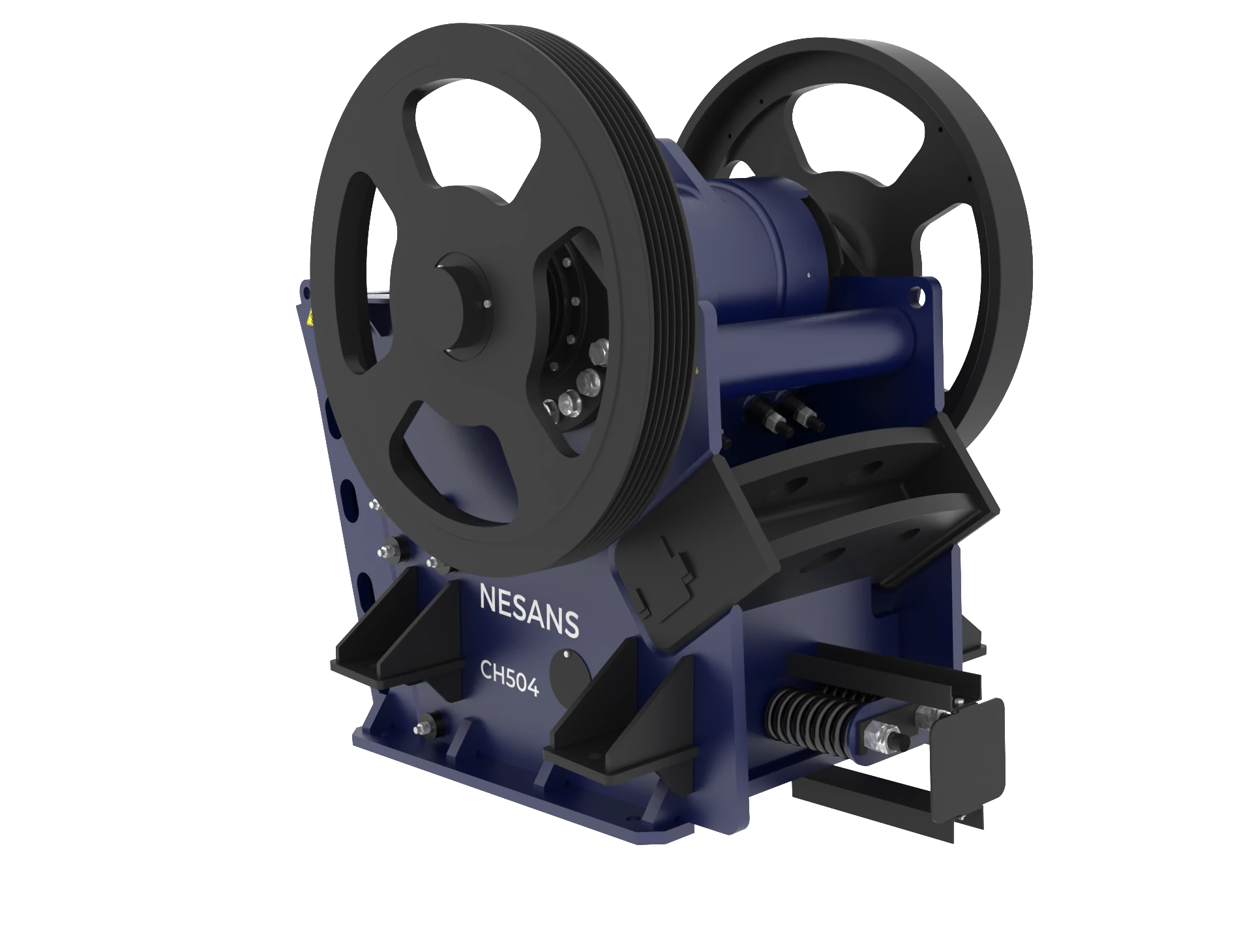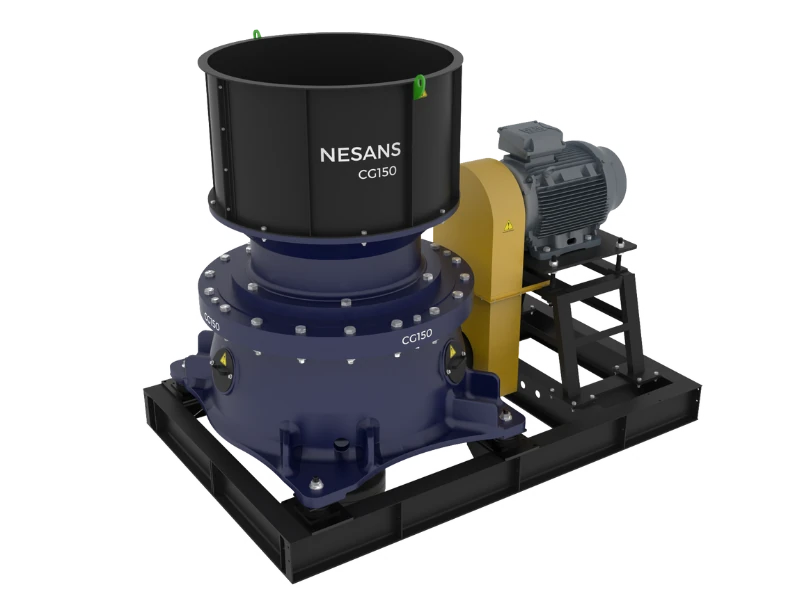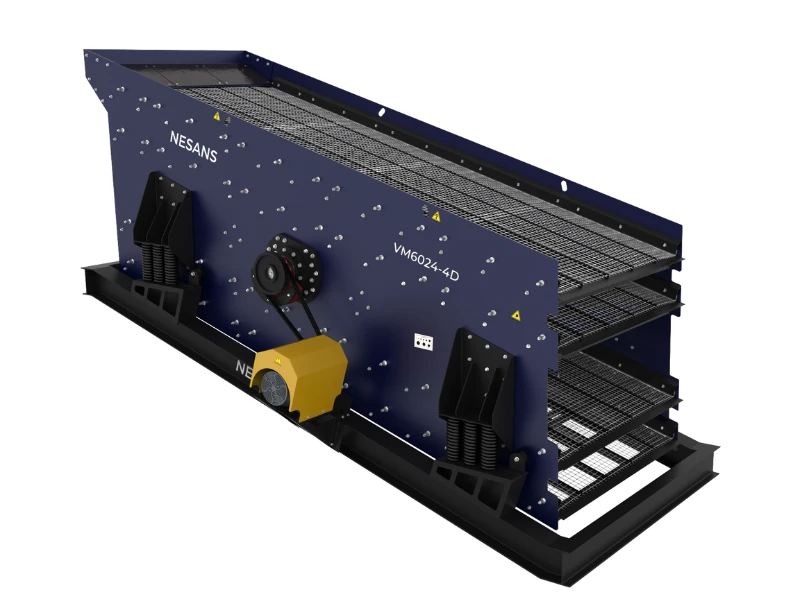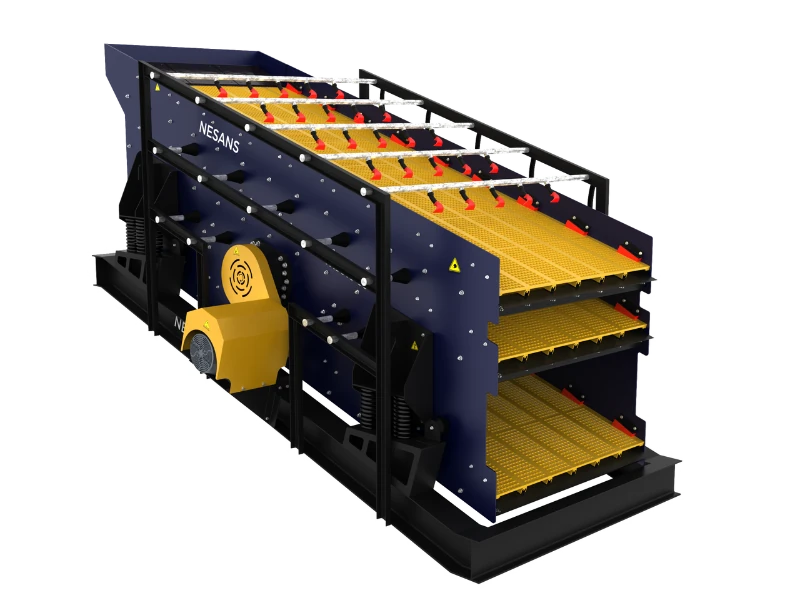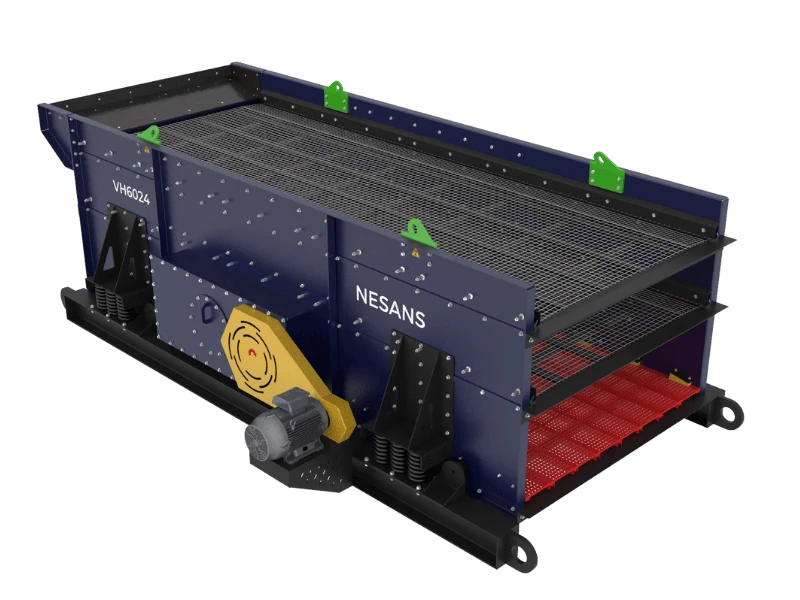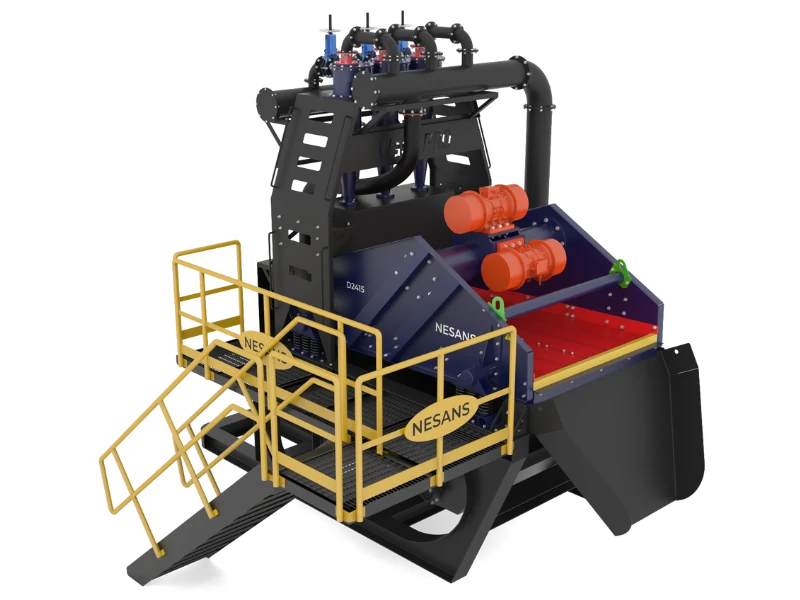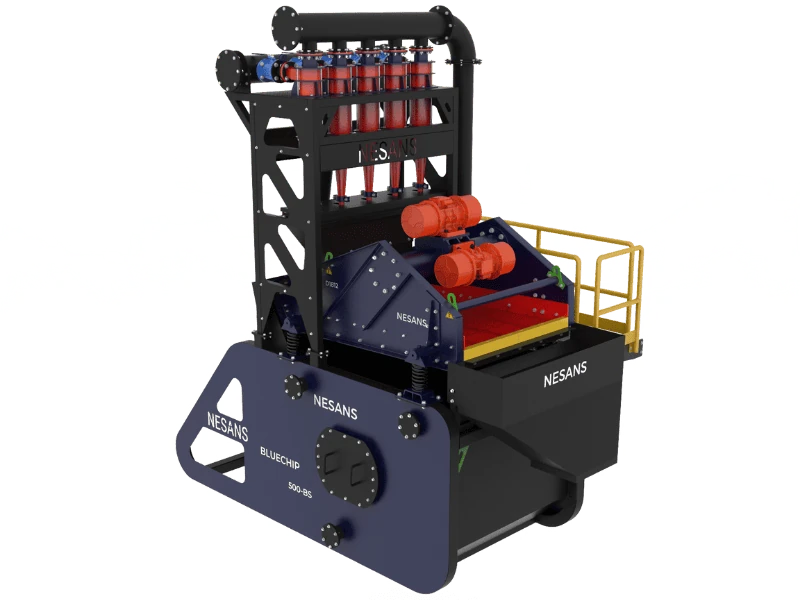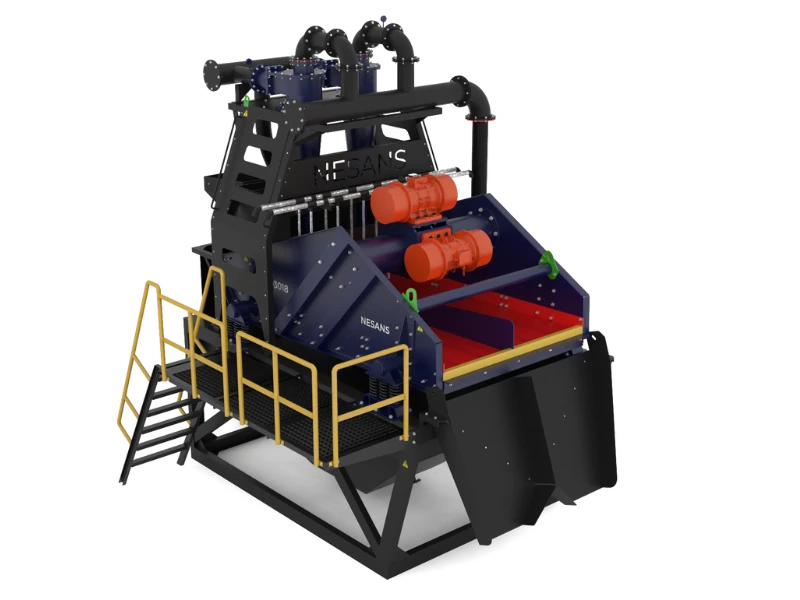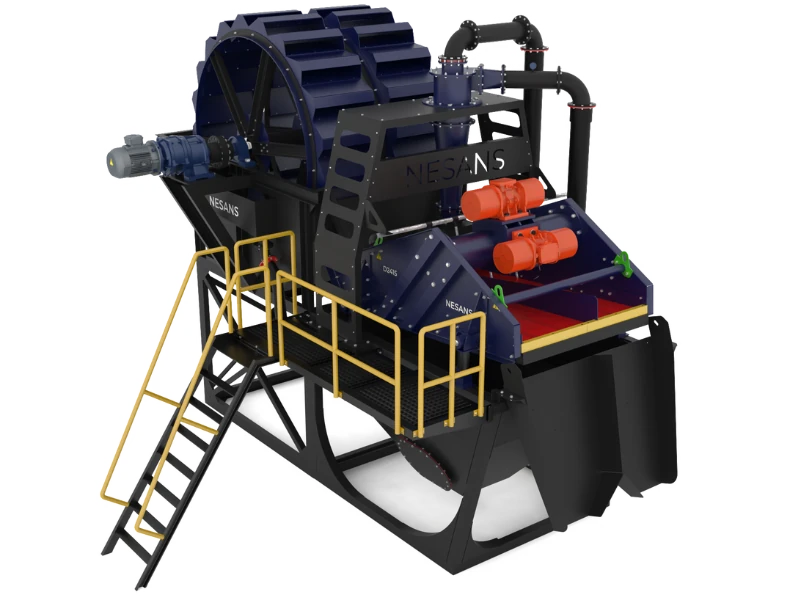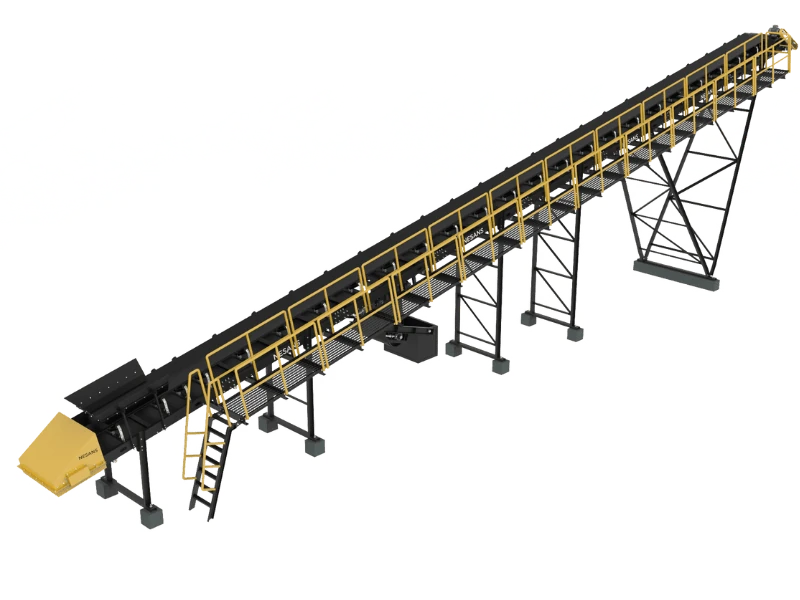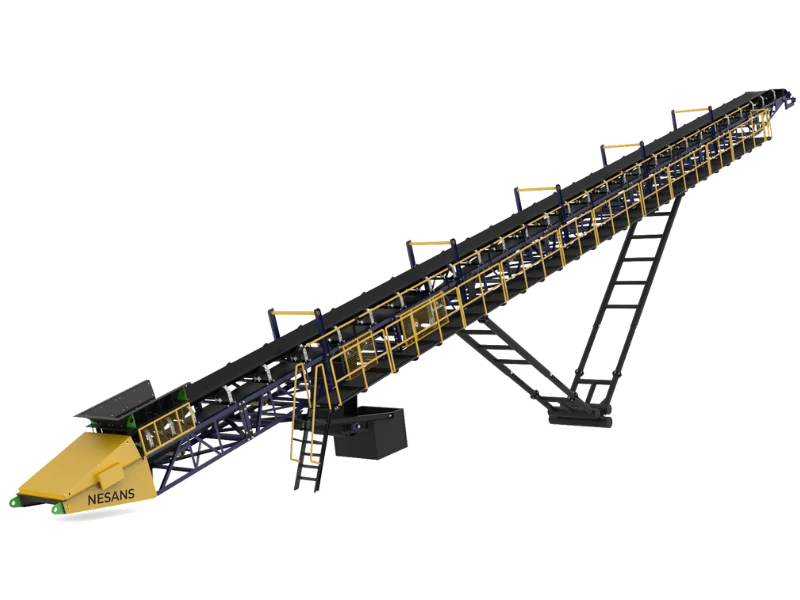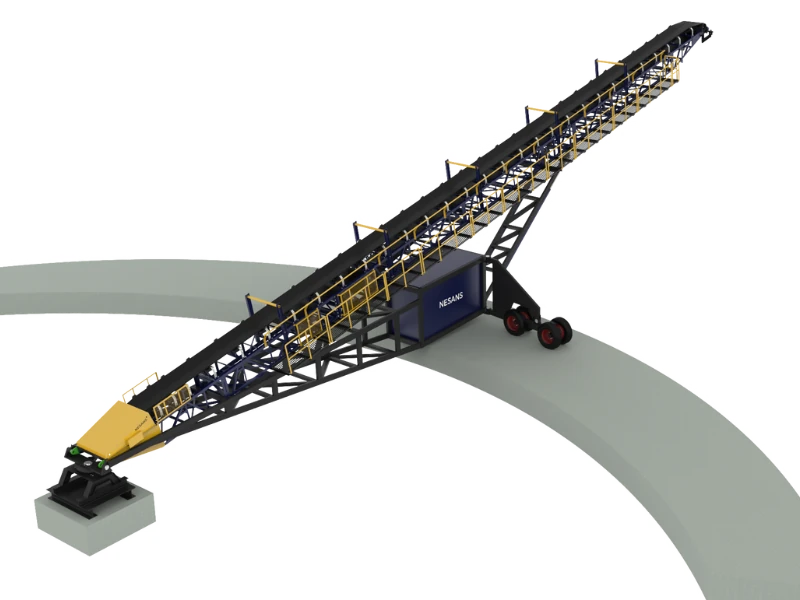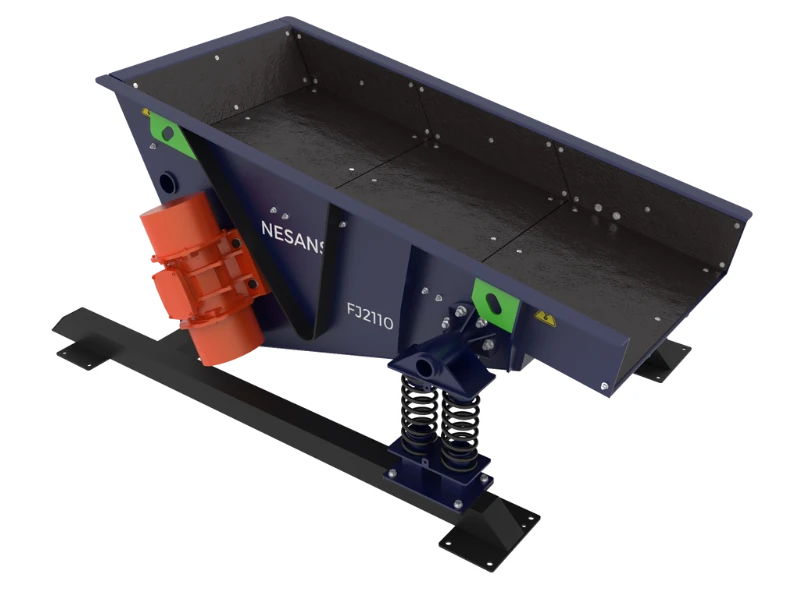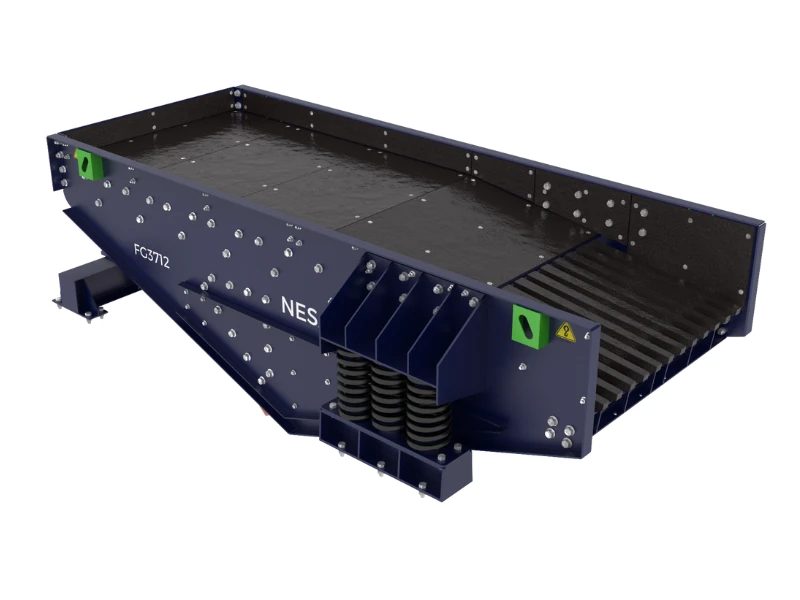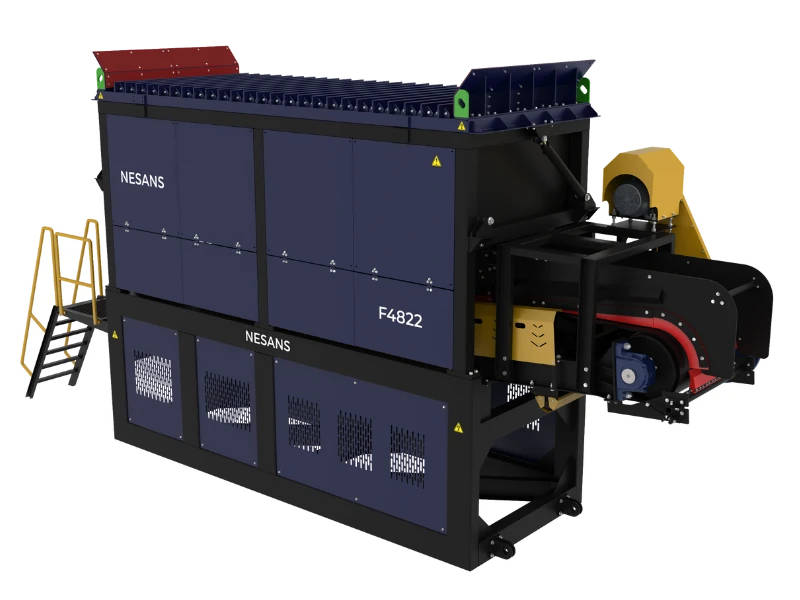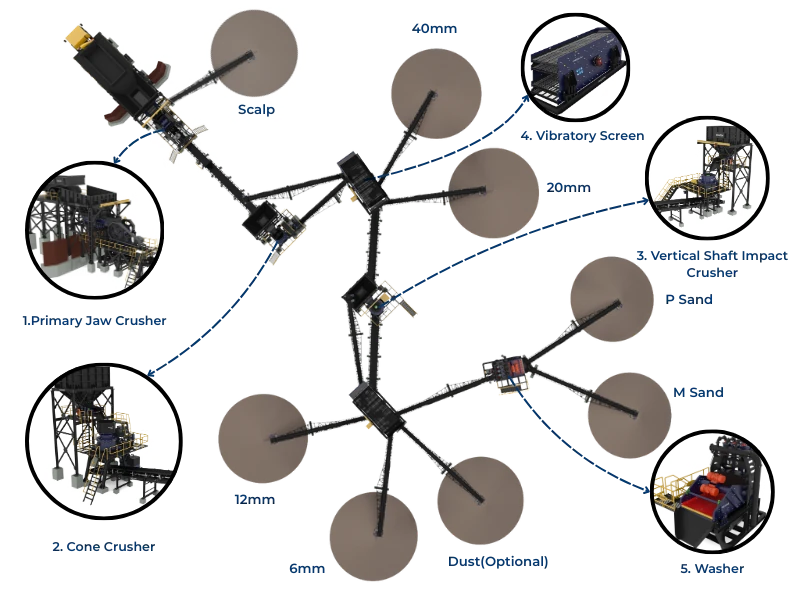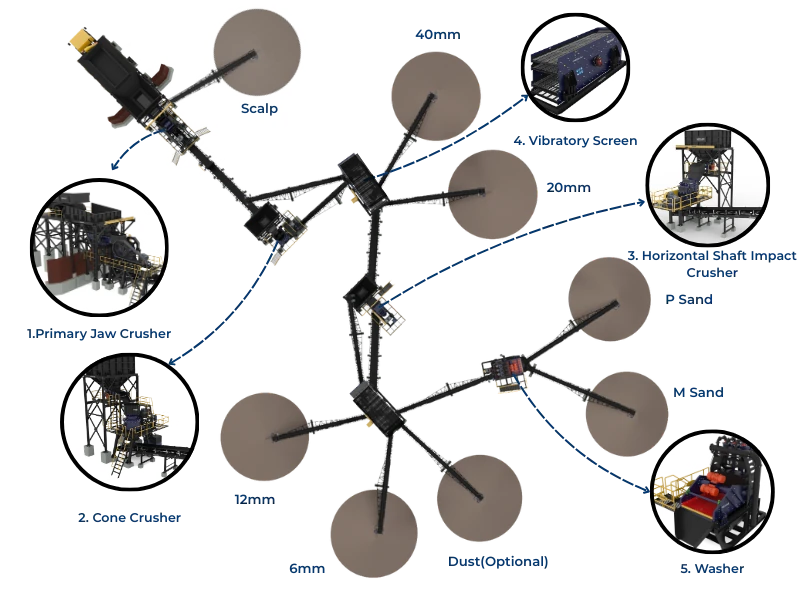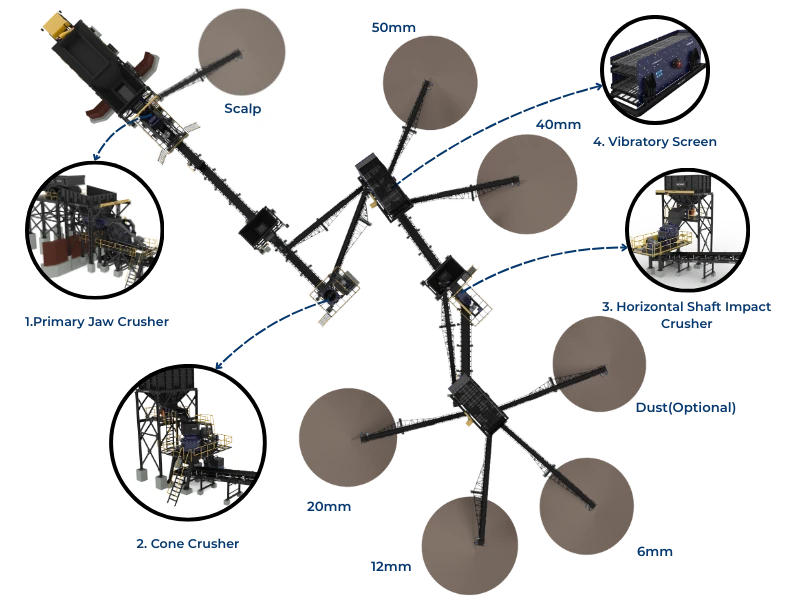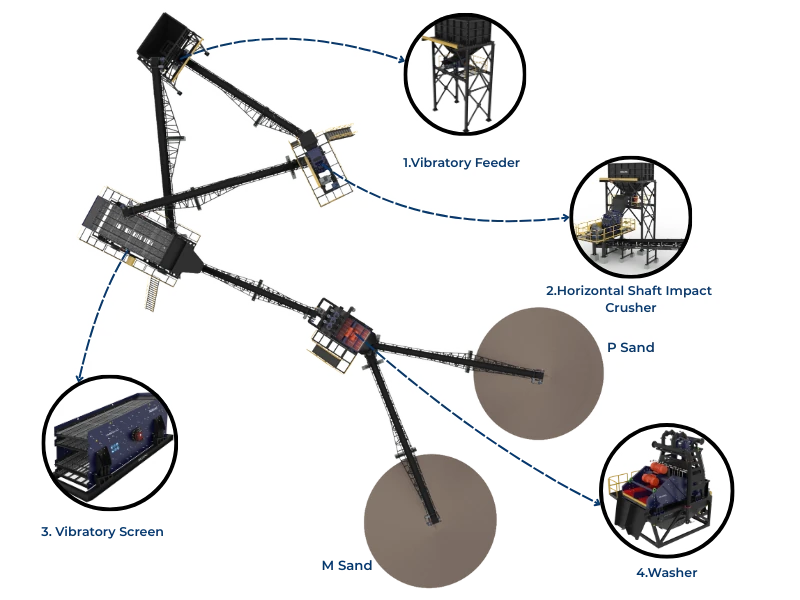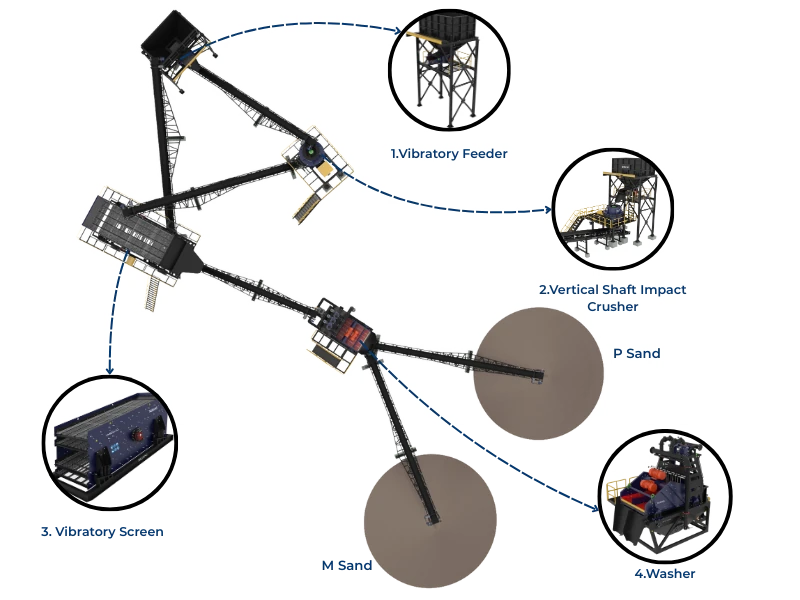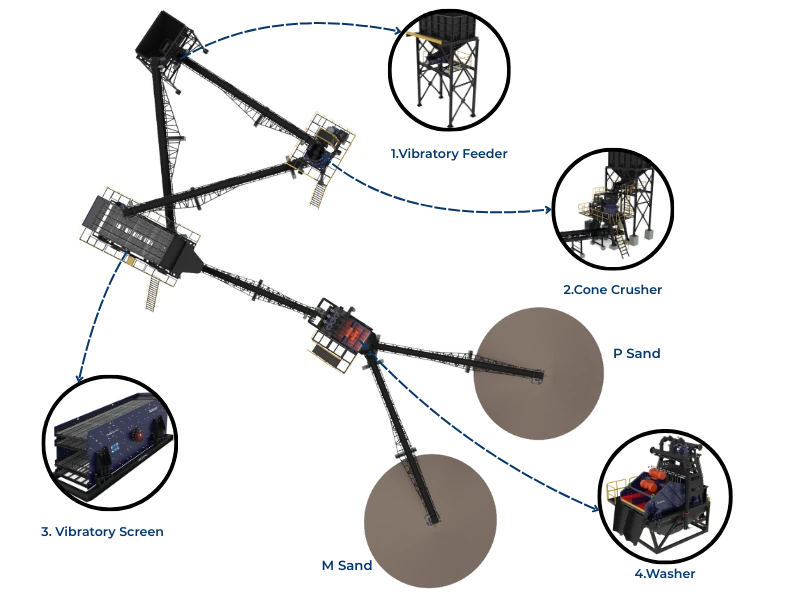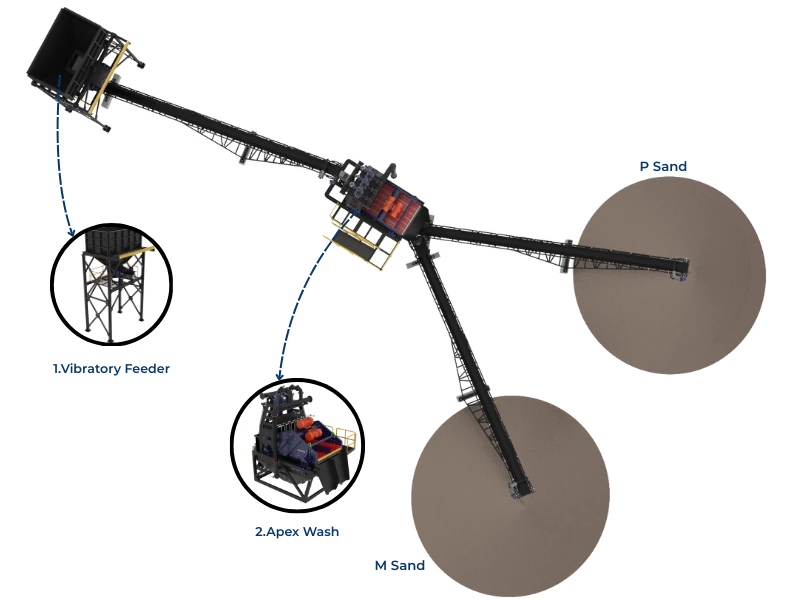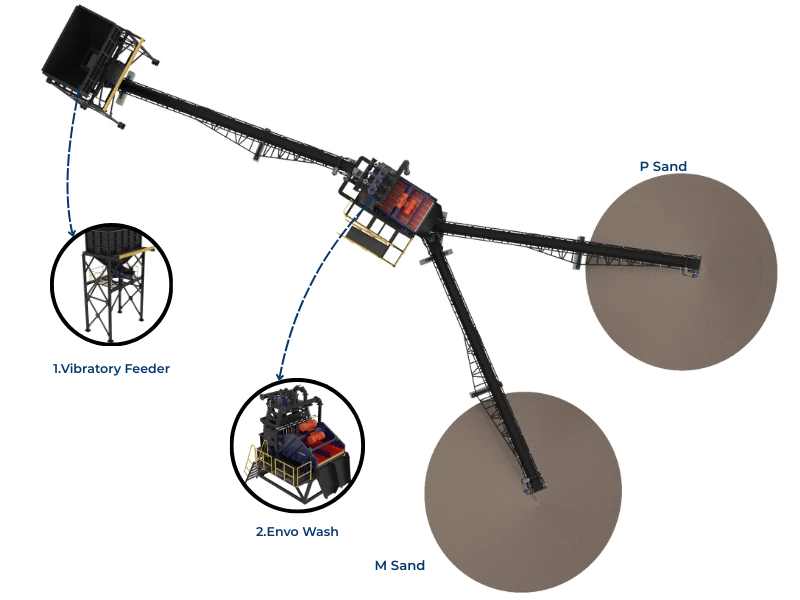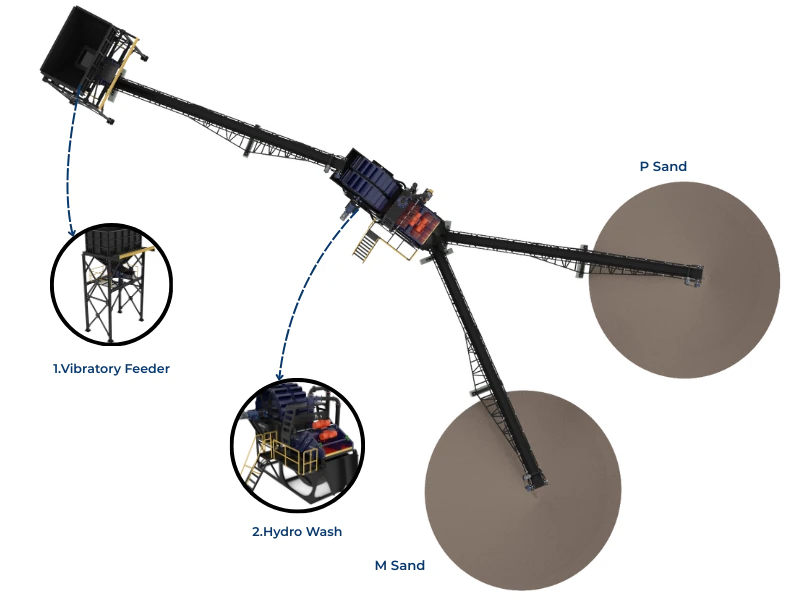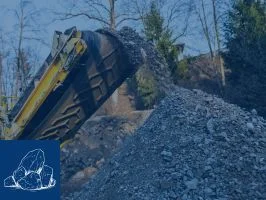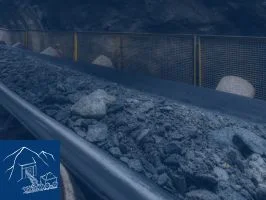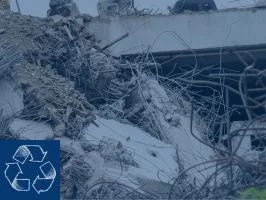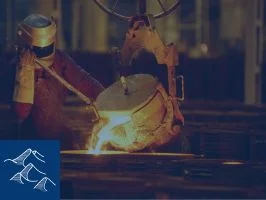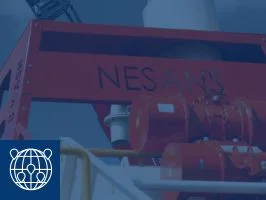Your stockpile contains uniform 10-15mm aggregate at the stacker discharge, yet material reclaimed from the pile shows 40% gradation variation—causing concrete mix rejections and ₹2 lakh monthly penalties for grade deviation. The stockpile hasn't changed the aggregate; it has segregated it through particle size separation during stacking and reclaim. Coarse particles roll to pile edges while fines concentrate at the center—creating invisible gradation zones that deliver inconsistent material to batching plants. The solution requires engineered stacking and reclaim methods that prevent segregation, delivering the same gradation from stockpile that entered it.
Material segregation is the natural tendency of mixed-size particles to separate by size, density, or shape during handling. In aggregate stockpiles, this manifests as coarse material migrating to pile perimeters while fines accumulate in the core—creating spatial gradation variation that undermines all upstream quality control efforts. A crushing plant may produce perfectly consistent 10-15mm material, yet segregation during stacking creates zones ranging from 8-11mm (fine-rich) to 13-18mm (coarse-rich). Reclaim from different pile locations delivers varying gradations to customers, causing concrete strength variation, mix adjustment costs, and contractual penalties.
This guide examines the physics of particle segregation, quantifies its economic impact, and presents stacking and reclaim strategies that maintain gradation uniformity from production through delivery—eliminating the hidden costs that erode aggregate profitability.
Understanding Particle Segregation Mechanisms
Segregation Physics in Stockpiles
Particle segregation occurs through multiple mechanisms that operate simultaneously during stockpile operations:
Trajectory Segregation (Primary Mechanism - 60-75% of total segregation):
- Particles leaving conveyor discharge follow ballistic trajectories determined by size, mass, and air resistance
- Large particles (high momentum) travel farther, landing at pile periphery
- Small particles (low momentum, high air resistance) drop near discharge point, concentrating at pile center
- Effect magnitude: 12-20mm particles travel 40-60% farther than 5-8mm particles at 4m drop height
- Mathematical model: Horizontal distance = (V₀² × sin(2θ))/g × (1 - k×A/m) where k=air resistance coefficient, A=particle surface area, m=mass
Rolling Segregation (25-35% of total segregation):
- Particles landing on pile slope surface roll downward under gravity
- Large particles have higher rolling momentum, traveling to pile base
- Small particles lodge in surface voids, remaining higher on slope
- Critical angle: Segregation maximized at slope angles 32-38° (typical aggregate repose angle)
- Impact factor: Coarse fraction at pile base 60-80% higher than pile center for 5-20mm mixed material
Percolation Segregation (5-10% of total segregation):
- Small particles filter through voids between large particles, migrating downward through pile
- Significant in coarse aggregates (40-80mm) with large inter-particle voids
- Less important in fine aggregates (<20mm) where voids are smaller
- Time-dependent: Increases with pile age as vehicle traffic and wind vibration promote percolation
⚠️ Economic Impact Example: A ready-mix concrete plant using segregated 10-15mm aggregate experiences 0.3-0.5 MPa strength variation in M30 grade concrete (target 30 MPa, achieving 29.5-30.5 MPa range). To guarantee minimum strength, they must increase cement content 8-12 kg/m³ (₹40-60/m³ additional cost). For 50,000 m³ annual production, segregation costs ₹20-30 lakhs in excess cement plus ₹5-8 lakhs in quality testing and mix adjustments—total ₹25-38 lakhs annually.
Quantifying Segregation in Stockpiles
Measurement and Assessment Methods
Systematic Sampling Protocol:
- Divide stockpile into grid (minimum 5 zones: center-top, center-mid, center-base, edge-mid, edge-base)
- Extract 10-15 kg samples from each zone using consistent sampling technique
- Perform sieve analysis on each sample per IS 2386 Part-1
- Calculate segregation index: SI = (Max% - Min%) / Mean% for key size fractions
- Segregation severity: SI <0.15 (acceptable), 0.15-0.30 (moderate), >0.30 (severe)
Example Segregation Analysis:
10-15mm aggregate specification: 95% passing 15mm, 5-15% passing 10mm, 0-5% passing 4.75mm
Sample Location Results:
- Center-Top: 98% passing 15mm, 28% passing 10mm, 12% passing 4.75mm (fine-rich)
- Center-Base: 96% passing 15mm, 18% passing 10mm, 6% passing 4.75mm (moderate fines)
- Edge-Mid: 94% passing 15mm, 8% passing 10mm, 2% passing 4.75mm (coarse-rich)
- Edge-Base: 91% passing 15mm, 4% passing 10mm, 1% passing 4.75mm (very coarse)
Segregation Index Calculation:
- For 10mm fraction: SI = (28% - 4%) / 14.5% average = 1.66 (severe segregation)
- For 4.75mm fraction: SI = (12% - 1%) / 5.25% average = 2.10 (very severe)
Interpretation: This stockpile exhibits severe segregation with 7× variation in fine content between center-top and edge-base locations. Material reclaimed from different zones fails to meet specification consistency, causing downstream quality issues.
Anti-Segregation Stacking Methods
Method 1: Chevron Stacking (Most Effective)
Operating Principle:
- Material deposited in multiple parallel ridges (chevrons) rather than single cone
- Conveyor or stacker travels longitudinally, depositing thin lifts across pile width
- Each lift covers entire pile footprint before starting next layer
- Prevents particle size separation by minimizing rolling distance
- Achieves segregation index <0.12 in properly implemented systems
Implementation Requirements:
- Mobile stacker conveyor (radial or tracked) or multiple fixed discharge points
- Layer thickness: 300-500mm per pass for 10-40mm aggregate
- Stacker travel speed: 0.3-0.6 m/s synchronized with material feed rate
- Pile geometry: Longitudinal ridges with 35-40° side slopes, flat-topped cross-section
Cost and Benefits:
- Mobile radial stacker: ₹25-40 lakhs investment
- Tracked stacker: ₹45-75 lakhs for high-capacity systems
- Reduces segregation index from 0.40-0.60 (cone stacking) to 0.08-0.12 (chevron)
- ROI: 2-3 years for operations with significant quality penalty costs
Method 2: Vertical Drop Stacking with Cone Splitting
Operating Principle:
- Material discharged vertically onto pile apex, minimizing trajectory segregation
- Cone splitter (inverted cone or pyramid) installed at discharge point
- Diverts material radially in all directions, creating symmetrical pile growth
- Reduces rolling distance and creates consistent slope angles
- Achieves segregation index 0.15-0.22 (moderate improvement)
Design Parameters:
- Cone splitter: 45-60° angle, diameter 40-60% of material stream width
- Vertical drop height: 2-4m (higher drops increase capacity but worsen segregation)
- Material velocity at impact: <6 m/s to minimize particle degradation
- Effective for stockpiles with fixed discharge point (non-mobile stackers)
Cost and Benefits:
- Cone splitter installation: ₹1.5-3.5 lakhs (fabrication and installation)
- Reduces segregation 30-40% vs. free-fall discharge
- Simple retrofit for existing systems, suitable for smaller operations
Method 3: Stockpile Blending Bins
Operating Principle:
- Material stored in multiple vertical silos or compartments rather than open piles
- Controlled discharge from multiple outlets blends material during reclaim
- Eliminates segregation through complete material mixing
- Most effective method but highest capital cost
- Segregation index <0.05 (negligible segregation)
System Configuration:
- 4-8 compartments per material size/type
- Capacity: 500-2,000 tons per compartment
- Discharge: Controlled feeders (vibrating or belt) proportion material from each compartment
- Automation: PLC control maintains blend ratios automatically
Cost and Benefits:
- System cost: ₹1.2-2.5 crores for 4,000-8,000 ton capacity
- Eliminates virtually all segregation-related quality variation
- Justified for high-value applications (precast concrete, asphalt plants) where quality consistency is critical
- ROI: 3-5 years including reduced quality costs and premium pricing for consistent material
Anti-Segregation Reclaim Strategies
Full-Face Reclaim (Optimal Method)
Operating Principle:
- Material removed uniformly across entire pile face (vertical or near-vertical cut)
- Reclaims all segregation zones simultaneously, blending coarse and fine fractions
- Reproduces average pile gradation regardless of localized segregation
- Requires specialized reclaim equipment (bucket-wheel reclaimer or front-end loader with proper technique)
Implementation with Front-End Loaders:
- Establish vertical pile face using dozer or grader
- Loader attacks pile from bottom to top in vertical passes
- Bucket penetrates full face height (3-4m) in single pass
- Avoid selective loading from pile base (captures only coarse material)
- Operator training critical—poor technique reintroduces segregation
Bucket-Wheel Reclaimers (Large Operations):
- Automated equipment travels along pile, cutting uniform vertical face
- Bucket wheel rotates, removing material from full pile height simultaneously
- Achieves consistent gradation batch-to-batch (CV <5% for key size fractions)
- Investment: ₹1.5-4 crores for 500-1,500 TPH capacity systems
- Justified for operations >500,000 tons/year with strict quality requirements
Multi-Point Reclaim
Operating Principle:
- Material reclaimed from multiple pile locations simultaneously or in rapid sequence
- Blends segregation zones during loading to delivery vehicle or batching system
- Practical for operations using front-end loaders without specialized reclaim equipment
Implementation Protocol:
- Divide pile into 4-6 zones (center, mid-radius, perimeter)
- Reclaim 1-2 buckets from each zone in rotation
- Load delivery truck or hopper with proportional material from all zones
- Avoid loading entire truck from single pile location
Effectiveness:
- Reduces gradation variation 50-70% vs. single-point reclaim
- No capital investment—requires only operator training and procedure implementation
- Adds 5-10% to loading time but eliminates quality variation costs
Case Study: Ready-Mix Plant Stockpile Optimization
Initial Situation
Operation:
- 50,000 m³ annual concrete production
- Four aggregate sizes: 10mm (fine), 10-15mm, 15-20mm, 20-40mm
- Cone stacking from fixed conveyor discharge, single-point loader reclaim
- Segregation index: 0.45-0.65 (severe) for 10-15mm and 15-20mm fractions
Quality Issues:
- Concrete strength variation: ±1.5-2.5 MPa on M30 grade (5-8% variation)
- 20-30% of batches require mid-mix adjustments (water, admixture)
- Cement content increased 10 kg/m³ to ensure minimum strength compliance
- Customer complaints: 15-20 per year for strength or workability issues
Economic Impact:
- Excess cement cost: 50,000 m³ × 10 kg/m³ × ₹5/kg = ₹25 lakhs/year
- Quality testing (additional trials): ₹4 lakhs/year
- Mix adjustments and re-batching: ₹3 lakhs/year
- Customer compensation and relationship costs: ₹8 lakhs/year
- Total segregation cost: ₹40 lakhs annually
Implemented Solution
Phase 1: Reclaim Optimization (Low-Cost Quick Win):
- Implemented multi-point reclaim protocol for loader operators
- Training program: 2 days, ₹30,000 cost
- Reduced segregation index from 0.55 to 0.28 (49% improvement)
- Concrete strength variation reduced to ±1.0 MPa
- Cement content reduced 5 kg/m³ (₹12.5 lakhs annual savings)
- ROI: Immediate (payback <1 month)
Phase 2: Stacking System Upgrade (Capital Investment):
- Installed mobile radial stacker with remote control: ₹32 lakhs investment
- Implemented chevron stacking for all aggregate fractions
- Reduced segregation index to 0.10-0.14 (77% total improvement vs. baseline)
- Concrete strength variation: ±0.4-0.6 MPa (consistent compliance)
- Eliminated mid-mix adjustments (saving ₹3 lakhs/year)
- Reduced cement content additional 5 kg/m³ (total 10 kg/m³ reduction vs. baseline)
Total Annual Benefits:
- Cement savings: ₹25 lakhs
- Eliminated quality testing redundancy: ₹2.5 lakhs
- Eliminated mix adjustments: ₹3 lakhs
- Customer satisfaction and retention value: ₹8 lakhs
- Total benefit: ₹38.5 lakhs/year
Capital Investment: ₹32 lakhs
Payback Period: 10 months
5-Year NPV (10% discount rate): ₹1.14 crores
Stockpile Design Considerations
Geometry and Layout
Pile Dimensions:
- Height: 6-10m optimal for 20-40mm aggregate, 4-6m for 5-20mm material (lower piles reduce segregation)
- Base Width: 2-3× pile height for stable geometry and equipment access
- Length: Determined by storage capacity—longer piles enable chevron stacking
- Capacity Formula: Volume = (W × H × L) / 2.5 for triangular cross-section, × 1.6 t/m³ for typical aggregate density = tons
Example: 40m long × 15m base width × 7m height = 1,680 m³ = 2,688 tons capacity for 1.6 t/m³ material
Separation Walls:
- Concrete or steel walls between stockpiles prevent material mixing
- Height: 0.8-1.2m sufficient for material retention
- Spacing: Minimum 4-5m between piles for loader access
- Cost: ₹1,500-2,500 per linear meter for concrete construction
Ground Preparation
Pad Construction:
- Concrete pad (150-200mm thick) with 2-3% slope for drainage
- Surface finish: Broom-finished concrete (not smooth—reduces segregation during pile formation)
- Reinforcement: Mesh or fiber for crack control in loader traffic areas
- Cost: ₹450-650/m² for complete construction
Drainage System:
- Perimeter drainage channels collect runoff
- Settlement basin or filter system prevents sediment discharge
- Required for environmental compliance and site cleanliness
Quality Control and Monitoring
Ongoing Assessment Program
Routine Testing (Weekly to Monthly):
- Sample material from reclaim stream (not directly from pile)
- Perform sieve analysis per IS 2386
- Compare to specification limits and historical averages
- Track coefficient of variation (CV) for key size fractions—target CV <8%
Segregation Audit (Quarterly):
- Full stockpile sampling from multiple zones as described earlier
- Calculate segregation index and compare to baseline
- Identify any changes in segregation patterns indicating equipment or procedure issues
- Document findings and implement corrective actions
Operator Performance Monitoring:
- Observe stacking and reclaim operations periodically
- Verify compliance with anti-segregation procedures
- Provide refresher training as needed (typically every 6-12 months)
- Recognition program for operators maintaining best quality metrics
Implementation Roadmap
Phase 1: Assessment and Quick Wins (Month 1-2):
- Conduct baseline segregation testing on existing stockpiles
- Calculate current economic impact (quality costs, material waste)
- Implement multi-point reclaim procedures (no capital required)
- Train loader operators on anti-segregation techniques
- Measure improvement and quantify savings
Phase 2: Low-Cost Improvements (Month 3-4):
- Install cone splitters on fixed discharge points
- Improve stockpile ground preparation and drainage
- Establish separation walls between material types
- Implement quality control monitoring program
- Investment: ₹3-8 lakhs
Phase 3: Capital Equipment (Month 6-12):
- Evaluate ROI for mobile stacker or blending system
- Obtain competitive quotations and select supplier
- Install equipment during planned production shutdown
- Commission and train operators
- Verify performance through segregation testing
- Investment: ₹25-250 lakhs depending on solution scale
Conclusion
Stockpile segregation is an invisible quality problem that costs aggregate producers and concrete manufacturers ₹2-5 lakhs monthly through cement overconsumption, quality variation, and customer penalties. Yet it remains largely unrecognized because material entering the stockpile appears identical to material leaving—the segregation occurs within the pile structure.
The solution requires understanding segregation mechanisms and implementing proven stacking and reclaim strategies. Low-cost interventions (multi-point reclaim, operator training) deliver 40-60% segregation reduction with immediate payback. Capital investments in mobile stackers or blending systems eliminate 75-90% of segregation, justifying their ₹25-250 lakh cost through quality consistency, reduced cement consumption, and premium pricing opportunities—achieving ROI in 10-36 months depending on operation scale and current segregation severity.
For operations facing quality penalties or overconsumption costs exceeding ₹15-20 lakhs annually, stockpile optimization represents one of the highest-return investments available in aggregate processing.

